Chapter: Artificial Intelligence(AI) : Knowledge Inference
KR Using Rules
KR Using Rules
In the
earlier slides, theKnowledge representations using predicate logic have been illustrated. The other popular
approaches to Knowledge representation are called production
rules , semantic net and frames.
Production rules, sometimes called
IF-THEN rules are most popular KR.
production rules are simple but
powerful forms of KR.
production rules provide the
flexibility of combining declarative and procedural representation for using
them in a unified
form. Examples of production rules :
IF condition THEN action
IF premise THEN conclusion
IF proposition p1 and proposition
p2 are true THEN proposition p3 is true
Advantages of production rules :
they are modular,
each rule define a small and
independent piece of knowledge. −
new rules may be added and old ones deleted
rules are usually independently of
other rules.
The production rules as knowledge
representation mechanism are used in the design of many "Rule-based systems" also called "Production systems" .
Types of Rules
Three types of rules are mostly
used in the Rule-based production systems.
■ Knowledge Declarative Rules :
These rules state all the facts and
relationships about a problem. Example :
IF inflation rate declines
THEN the price of gold goes down.
These rules are a part of the
knowledge base.
■ Inference Procedural Rules
These rules advise on how to solve
a problem, while certain facts are known.
Example :
IF the data needed is not in the
system THEN request it from the user.
These rules are part of the
inference engine.
Meta rules
These are rules for making rules.
Meta-rules reason about which rules should be considered for firing.
Example :
IF the rules which do not mention
the current goal in their premise, AND there are rules which do mention the
current goal in their premise, THEN the former rule should be used in
preference to the latter.
Meta-rules
direct reasoning rather than actually performing reasoning.
Meta-rules
specify which rules should be considered and in which order they should be
invoked.
1. Procedural versus Declarative Knowledge
These two types of knowledge were
defined in earlier slides.
■
Procedural Knowledge :
Includes : rules, strategies, agendas, procedures, models. These explains what to do in order to reach a certain
conclusion. Example
Rule: To determine if Peter or
Robert is older, first find their ages.
It is knowledge about 'how to do' something. It manifests
itself in the doing of something, e.g., manual or mental skills cannot reduce
to words. It is held by individuals in a way which does not allow it to be
communicated directly to other individuals.
Accepts a description of the steps
of a task or procedure. It Looks similar to declarative knowledge, except that
tasks or methods are being described instead of facts or things.
■
Declarative Knowledge : knowing 'what', knowing 'that'
Includes : concepts, objects, facts, propositions, assertions, models.
It is knowledge about facts and relationships, that
can be expressed in simple and
clear statements,
can be added and modified without
difficulty.
Examples : A car has four tyres; Peter is older than Robert.
Declarative knowledge and explicit
knowledge are articulated knowledge and may be treated as synonyms for most
practical purposes. Declarative knowledge is represented in a format that can
be manipulated, decomposed and analyzed independent of its content.
Comparison :
Comparison between Procedural and
Declarative Knowledge :
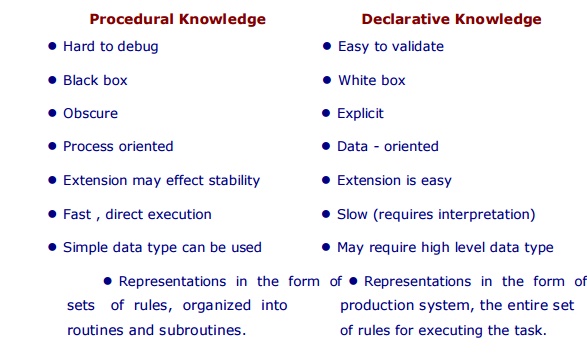
Comparison :
Comparison between Procedural and
Declarative Language :
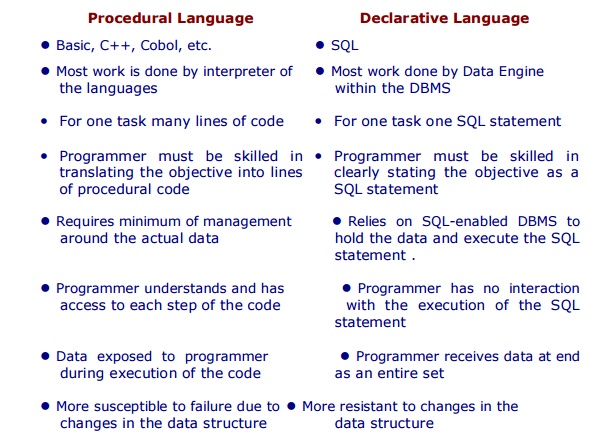
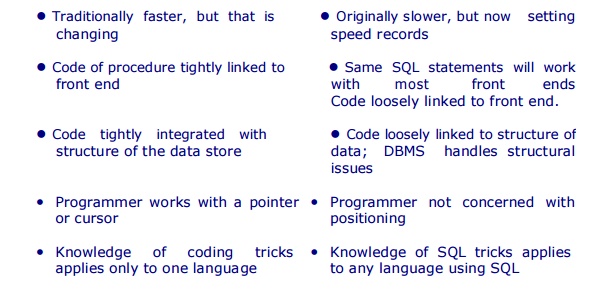
2. Logic Programming
Logic programming offers a
formalism for specifying a computation in terms of logical relations between
entities.
logic program is a collection of logic statements.
programmer describes all relevant logical relationships
between the various entities.
computation determines whether or not, a
particular conclusion follows from those
logical statements.
Characteristics of Logic program
Logic program is characterized by
set of relations and inferences. −
program consists of a set of axioms and a
goal statement.
rules of
inference determine
whether the axioms are sufficient to ensure the
truth of the goal statement.
execution of a logic program corresponds to
the construction of a proof of the goal statement from
the axioms.
programmer specify basic logical
relationships, does not specify the manner
in which inference rules are applied.
Thus Logic + Control = Algorithms
Examples of Logic Statements
Statement
A grand-parent is a parent of a
parent.
Statement expressed in more closely
related logic terms as A
person is a grand-parent if she/he has a child and that child is a parent.
Statement expressed in first order
logic as
(for all) x: grandparent (x, y)
:- parent (x, z), parent (z, y)
read as x is the grandparent of y
if x is a parent of z and z is a
parent of y
Logic Programming Language
A programming language includes :
the syntax
the semantics of programs and
the computational model.
There are many ways of organizing
computations. The most familiar paradigm is procedural. The program specifies a computation by saying
"how" it is to be performed.
FORTRAN, C, and Object-oriented
languages fall under this general approach.
Another paradigm is declarative. The program specifies a
computation by giving the properties of a correct answer. Prolog and logic data language (LDL)
are examples of declarative languages, emphasize the logical properties of a computation.
Prolog and LDL are called logic
programming languages.
PROLOG (PROgramming
LOGic) is the most popular Logic programming language rose within the realm of Artificial Intelligence (AI). It
became popular with AI resea hers, who know more about "what" and
"how" intelligent behavior is achieved.
Syntax and Terminology (relevant to Prolog programs)
In any language, the formation of
components (expressions, statements,
etc.), is guided by syntactic
rules.
The components are divided into two
parts:
data components and (B) program
components.
Data components :
Data components are collection of
data objects that follow hiera hy.
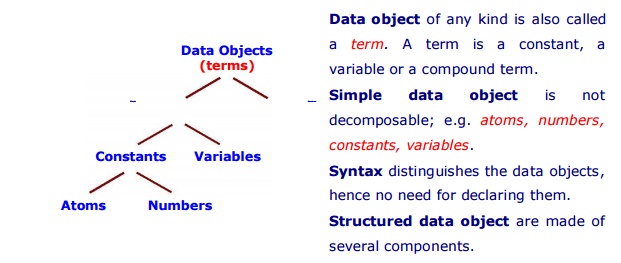
All these data components are
explained in next slide.
Data Objects :
The data objects of any kind is
called a term.
◊ Term : Examples
‡ Constants:
Denote elements such as integers, floating point, atoms.
‡ Variables:
Denote a single but unspecified
element; symbols for variables begin with an uppe ase letter or an underscore.
‡ Compound terms:
Comprise a functor
and sequence of one or more compound terms called arguments.
► Functor: is
characterized by its name and number of arguments;
name is an atom, and number of arguments is
arity.
ƒ/n = ƒ( t1 , t2,
. . . tn )
where ƒ is name of the functor
and is of arity n
t i
's
are the argument
ƒ/n denotes functor ƒ of arity n
Functors with same name but
different arities are distinct.
‡ Ground and non-ground:
Terms are
ground if they contain no variables (only constant signs); otherwise they are non-ground.
Goals are
atoms or compound terms, and are generally non-ground.
Simple Data Objects : Atoms, Numbers, Variables
◊
Atoms
‡ a lower-case letter, possibly
followed by other letters of either case, digits, and underscore character.
e.g. a greaterThan two_B_or_not_2_b
‡ a
string of special characters such as: +
- * / \ = ^ < > : ~ # $ &
e.g. <> ##&& ::=
‡ a string of any characters enclosed within
single quotes.
e.g. 'ABC' '1234' 'a<>b'
‡ following
are also atoms ! ; [] {}
Numbers
applications involving heavy
numerical calculations are rarely written in Prolog.
‡ integer representation: e.g. 0 -16 33
+100
‡ real
numbers written in standard or
scientific notation,
e.g. 0.5
-3.1416 6.23e+23 11.0e-3 -2.6e-2
Variables
begins by a
capital letter, possibly followed by other letters of either case, digits, and
underscore
character. e.g. X25 List Noun_Phrase
Structured Data Objects : General Structures , Special
Structures
.
General Structures
a structured
term is syntactically formed by a functor and a list of arguments.
functor
is an atom.
list
of arguments appear between parentheses.
arguments
are separated by a comma.
each
argument is a term (i.e., any Prolog data object).
the
number of arguments of a structured term is called its arity.
‡ e.g. greaterThan(9, 6) f(a, g(b, c), h(d)) plus(2, 3, 5)
Note : a structure in Prolog is a
mechanism for combining terms together, like integers 2, 3, 5 are combined with
the functor plus.
Special Structures
In Prolog an
ordered collection of terms is called a list .
‡ Lists
are structured terms and Prolog offers a convenient
notation to represent them:
Empty list is denoted by the atom [ ].
Non-empty list carries element(s)
between square brackets,
separating elements by comma.
e.g. [bach, bee] [apples, oranges, grapes]
Program Components
A Prolog program is a collection of
predicates or rules.
A predicate establishes a
relationships between objects.
Clause, Predicate, Sentence,
Subject
Clause
is a collection of
grammatically-related words .
Predicate
is composed of one or more clauses.
Clauses
are the building blocks of sentences;
every sentence contains one or more clauses.
A
Complete Sentence has two parts: subject and predicate. o subject is what (or whom) the sentence is about.
predicate tells something about the
subject.
Example
1 : "cows eat grass".
It is a clause, because it contains
the subject "cows" and the predicate "eat grass."
Example 2 : "cows eating grass are visible
from highway"
This is a complete clause.
the subject "cows eating
grass" and the predicate "are visible from the
highway"
makes complete thought.
(b) Predicates & Clause
Syntactically a predicate is composed of one or
more clauses.
‡ The
general form of clauses is
<left-hand-side> :- <right-hand-side>.
where LHS is a single goal called "goal" and RHS is composed of one or more
goals, separated by commas, called "sub-goals" of the goal on left-hand side.
The symbol " :- " is pronounced as "it is the case" or "such that"
‡ The
structure of a clause in logic program

Literals represent the possible choices in
primitive types the particular language. Some of the
choices of types of literals are often integers, floating point, Booleans and
character strings.
‡ Example
: grand_parent (X, Z) :- parent(X, Y), parent(Y, Z).
parent (X, Y) :- mother(X, Y).
parent (X, Y) :- father(X, Y).
Read as if x is mother of y then x
is parent of y
Interpretation:
A clause
specifies the conditional truth of the goal on the LHS; goal on LHS is assumed
to be true if the sub-goals on RHS are all true. A predicate is true if at
least one of its clauses is true.
An individual "X" is the grand-parent of "Z" if a parent of that same "X" is "Y" and "Y" is the parent of that "Z".
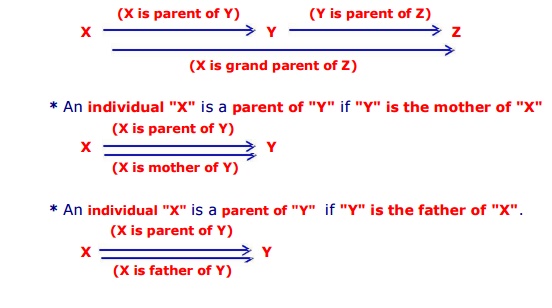
Unit Clause - a special Case
Unlike the previous example of
conditional truth, one often encounters unconditional relationships that hold.
In Prolog the clauses that are
unconditionally true are called unit clause or fact .
Example : Unconditionally
relationships say 'X' is
the father of 'Y' is unconditionally true.
This relationship as a Prolog clause is
father(X, Y) :- true.
Interpreted as relationship of
father between X and Y is always true; or simply stated as X
is father of Y .
Goal true is built-in in Prolog and
always holds.
Prolog offers a simpler syntax to
express unit clause or fact
father(X, Y)
ie
the " :- true " part is simply omitted.
Queries
In Prolog the queries are
statements called directive. A special case of directives, are called queries.
Syntactically,
directives are clauses with an empty left-hand side. Example : ? - grandparent(Q, Z).
This query Q
is interpreted as : Who is a grandparent of Z ?
By issuing queries Q,
Prolog tries to establish the validity of specific relationships.
The answer from previous slides is (X
is grand parent of Z)
The result
of executing a query is either success or failure Success, means the goals specified in the query holds according to
the facts and rules of the program.
Failure, means the goals specified in the query does not hold according to the facts and rules of
the program.
• Programming Paradigms : Models of Computation
A complete description of a
programming language includes the computational
model, syntax, semantics, and pragmatic considerations that shape the language.
Models of Computation :
A computational model is a
collection of values and operations, while computation is the application of a
sequence of operations to a value to yield another value.
There are three basic computational
models :
(a) Imperative, (b)
Functional, and (c) Logic.
In addition to these, there are two
programming paradigms :
(a) concurrent (b) object-oriented programming .
While, these two are not models of
computation, but they rank in importance with computational models.
Imperative Model
The
Imperative model of
computation, consists of
a state and an
operation of assignment which is used to
modify the state.
Programs consist of sequences of commands.
Computations are changes in the
state.
Example : Linear function
A linear function y = 2x + 3
can be written as
Y := 2 ∗ X + 3
The implementation requires to
determines the value of X in the state and then creates a new state which differs
from the old state.
New State: X = 3, Y = 9,
The imperative model is closest to
the hardware model on which programs are executed, that makes it most efficient
model in terms of execution time.
Functional model
The Functional model of
computation, consists of a set of values, functions, and the operation of
functions. The functions may be named and composed with other functions. It can
take other functions as arguments and return results.
Programs consist of definitions of
functions. Computations are application of functions to values.
‡ Example
1 : Linear function
A linear function y = 2x + 3 can be
defined as : f (x) = 2 ∗
x + 3
‡ Example
2 : Determine a value for Ci umference.
Assign a value to Radius, that
determines a value for Ci umference.
Ci umference = 2 × pi × radius , where pi = 3.14
Generalize Ci umference with the variable
"radius" ie
Ci umference(radius) = 2 × pi × radius , where pi = 3.14
Functional models are developed
over many years. The notations and methods form the base upon which problem
solving methodologies rest.
Logic Model
The logic model of computation is
based on relations and logical inference.
Programs consist of definitions of
relations.
Computations are inferences (is a
proof).
‡ Example
1 : Linear function
A linear function y = 2x + 3
can be represented as :
f (X , Y) if Y is 2 ∗
X + 3.
Here the function represents the
relation between X and Y.
‡ Example 2: Determine a value for Ci umference.
The ci umference computation can be
represented
as:
Ci le (R , C) if Pi = 3.14 and C = 2 ∗
pi ∗ R.
Here the function is represented as
the relation between radius R and ci umference C.
Example 3: Determine the mortality
of Socrates and Penelope. The program is to determine the mortality of Socrates
and Penelope.
The fact given that Socrates and
Penelope are human.
The rule is that all humans are
mortal, that is
for all X, if X is human then X is mortal.
To determine the mortality of
Socrates or Penelope, make the
assumption that there are no
mortals, that is
KR – Logic - models of computation
‡ The
equivalent form of the facts and rules stated before are
human (Socrates)
mortal (X) if human (X)
To determine the mortality of
Socrates and Penelope, we made the assumption that there are no mortals i.e. ¬ mortal (Y)
Computation (proof) that Socrates
is mortal

Explanation :
The 1st line
is the statement "Socrates
is a man."
*
The 2nd line is a phrase "all human are mortal"
into the equivalent "for all X, if X
is a man then X is mortal".
The 3rd line is added to the set to
determine the mortality of Socrates.
The 4th line is the deduction from
lines 2 and 3. It is justified by the inference rule modus tollens which states that if the conclusion of a rule is known to be false, then so is the hypothesis.
Variables X and Y are unified
because they have same value.
By unification, Lines 5, 4b, and 1
produce contradictions and identify Socrates as mortal.
Note that, resolution is an
inference rule which looks for a contradiction and it is facilitated by
unification which determines if there is a substitution which makes two terms
the same.
Logic model formalizes the
reasoning process. It is related to relational data bases and expert systems.
3. Forward versus Backward Reasoning
Rule-Based system a hitecture
consists a set of rules, a set of facts, and
an inference engine. The need is to find what new facts can be
derived.
Given a set of rules, there are
essentially two ways to generate new
knowledge: one, forward chaining and the other, backward chaining.
■ Forward chaining : also called data driven.
It starts with the facts, and sees
what rules apply.
■ Backward chaining : also called goal driven.
It starts with something to find
out, and looks for rules that will help in answering it.
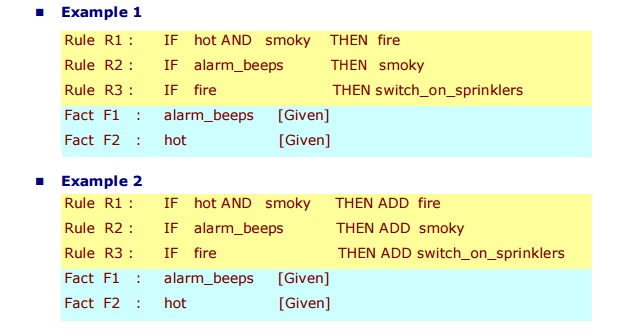
■
Example 3 : A typical Forward Chaining
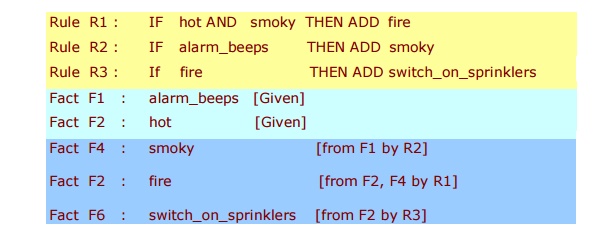
■
Example 4 : A typical Backward Chaining
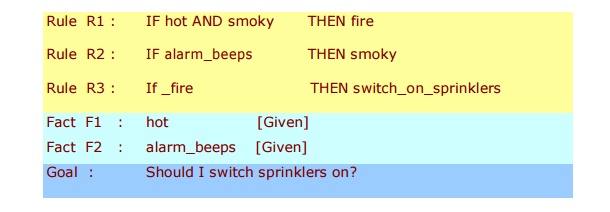
Forward Chaining
The Forward chaining system,
properties , algorithms, and conflict resolution strategy are illustrated.
■ Forward chaining system
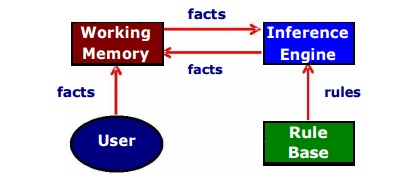
facts are
held in a working memory
condition-action
rules represent actions to be taken when specified facts occur in working
memory.
typically,
actions involve adding or deleting facts from the working memory.
Properties of Forward Chaining
all rules
which can fire do fire.
can be
inefficient - lead to spurious rules firing, unfocused problem solving
set of rules
that can fire known as conflict set.
decision
about which rule to fire is conflict resolution.
■ Forward chaining algorithm – I

Apply on the Example 2 extended (adding 2 more rules and 1 fact)

Now, two rules can fire (R2
and R4)

■
Forward chaining algorithm - II
(applied to example 2 above )
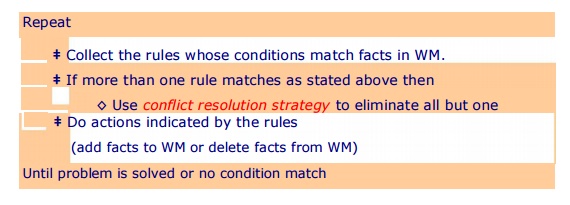
Repeat
Collect the rules whose conditions
match facts in WM.
If more than one rule matches as
stated above then
◊ Use conflict resolution strategy to eliminate all but one
‡ Do actions indicated by the rules
(add facts to WM or delete facts from WM)
Until problem is solved or no condition match
Conflict Resolution Strategy
Conflict set is the set of rules that have their
conditions satisfied by working memory elements.
Conflict resolution normally selects a single rule to
fire. The popular conflict resolution mechanisms are :
Refractory, Recency,
Specificity.
Refractory
a
rule should not be allowed to fire more than once on the same data.
discard
executed rules from the conflict set.
prevents
undesired loops.
Recency
rank
instantiations in terms of the recency of the elements in the premise of the
rule.
rules
which use more recent data are preferred.
working
memory elements are time-tagged indicating at what cycle each fact was added to
working memory.
Specificity
rules
which have a greater number of conditions and are therefore more difficult to
satisfy, are preferred to more general rules with fewer conditions.
more
specific rules are „better‟ because they take more of the data into account.
Alternative to Conflict Resolution – Use Meta Knowledge
Instead of conflict resolution
strategies, sometimes we want to use knowledge in deciding which rules to fire.
Meta-rules reason about which rules
should be considered for firing. They direct reasoning rather than actually
performing reasoning.
to guide sea
Meta-knowledge : knowledge about
knowledge h.
Example of meta-knowledge
IF conflict set contains any rule (c ,
a) such that
a = "animal is mammal''
THEN fire (c , a)
‡ This example says meta-knowledge
encodes knowledge about how to guide sea h for solution.
Meta-knowledge, explicitly coded in
the form of rules with "object level" knowledge.
Backward Chaining
Backward chaining system and the
algorithm are illustrated.
Backward chaining system
‡ Backward chaining means reasoning
from goals back to facts. The idea is to focus on the sea h.
Rules and
facts are processed using backward chaining interpreter.
Checks
hypothesis, e.g. "should I switch
the sprinklers on?"
Backward chaining algorithm
Prove goal G
If G is in the initial facts , it is
proven.
Otherwise, find a rule which can be
used to conclude G, and try to prove each of that rule's conditions.
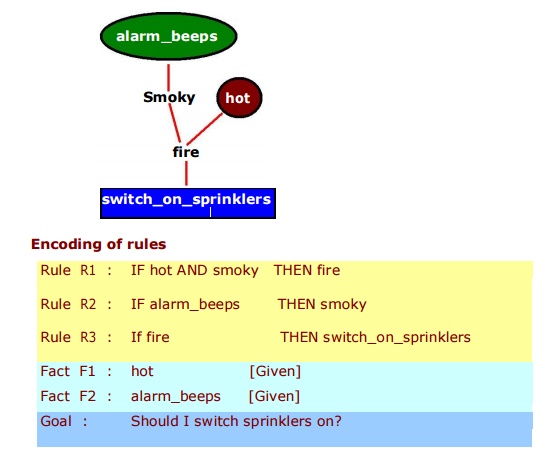
Forward vs Backward Chaining
Depends on problem, and on
properties of rule set.
Backward
chaining is likely to be better if there is clear hypotheses. Examples :
Diagnostic problems or classification problems, Medical expert systems
Forward
chaining may be better if there is less clear hypothesis and want to see what
can be concluded from current situation;
Examples
: Synthesis systems - design /
configuration.
4. Control Knowledge
An algorithm consists of : logic
component, that specifies the knowledge to be used in solving problems, and control component, that determines the
problem-solving strategies by means of which that knowledge is used.
Thus Algorithm = Logic + Control .
The logic component determines the
meaning of the algorithm whereas the control component only affects its
efficiency.
An algorithm may be formulated in
different ways, producing same behavior. One formulation, may have a clear
statement in logic component but employ a sophisticated problem solving
strategy in the control component. The other formulation, may have a
complicated logic component but employ a simple problem-solving strategy.
The efficiency of an algorithm can
often be improved by improving the control component without changing the logic
of the algorithm and therefore without changing the meaning of the algorithm.
The trend in databases is towards
the separation of logic and control. The programming languages today do not
distinguish between them. The programmer specifies both logic and control in a
single language. The execution mechanism exe ises only the most rudimentary
problem-solving capabilities.
Computer programs will be more
often correct, more easily improved, and more readily adapted to new problems
when programming languages separate logic and control, and when execution
mechanisms provide more powerful problem-solving facilities of the kind
provided by intelligent theorem-proving systems.
Related Topics